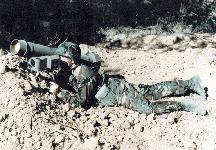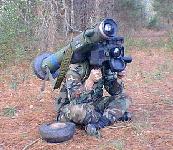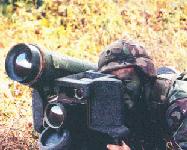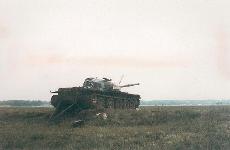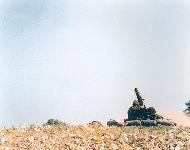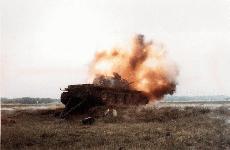 The Javelin is a manportable, fire-and-forget, antitank missile employed by
dismounted infantry to defeat current and future threat armored combat vehicles.
Javelin is intended to replace the Dragon system in the Army and the Marine Corps.
JAVELIN has significant improvements over DRAGON.
The Javelin's range of approximately 2,500 meters is more than twice that of its predecessor, the Dragon. The Javelin has secondary capabilities against helicopters and ground-fighting positions. It is equipped with an imaging infrared (I2R) system and a fire-and-forget guided missile. The Javelin's normal engagement mode is top-attack to penetrate the tank's most vulnerable armor. It also has a direct-attack capability to engage targets with overhead cover or in bunkers. Its "soft launch" allows employment from within buildings and enclosed fighting positions. The soft launch signature limits the gunner's exposure to the enemy, thus increasing survivability. JAVELIN is also much more lethal than DRAGON. It has a top attack dual warhead capability which can defeat all known enemy armor systems.
The Javelin is a manportable, fire-and-forget, antitank missile employed by
dismounted infantry to defeat current and future threat armored combat vehicles.
Javelin is intended to replace the Dragon system in the Army and the Marine Corps.
JAVELIN has significant improvements over DRAGON.
The Javelin's range of approximately 2,500 meters is more than twice that of its predecessor, the Dragon. The Javelin has secondary capabilities against helicopters and ground-fighting positions. It is equipped with an imaging infrared (I2R) system and a fire-and-forget guided missile. The Javelin's normal engagement mode is top-attack to penetrate the tank's most vulnerable armor. It also has a direct-attack capability to engage targets with overhead cover or in bunkers. Its "soft launch" allows employment from within buildings and enclosed fighting positions. The soft launch signature limits the gunner's exposure to the enemy, thus increasing survivability. JAVELIN is also much more lethal than DRAGON. It has a top attack dual warhead capability which can defeat all known enemy armor systems.  The Javelin is a tactical precision engagement system that enhances the Army's ability to dominate the ground maneuver battle. The Javelin's impact on scout capabilities will be significant. It will allow dismounted scouts to execute
reconnaissance and combat patrols with a relatively lightweight thermal sight. It will also give dismounted patrols
the capability of dealing with unexpected armored vehicle threats. (Scouts, however, will not use the Javelin to
seek out and destroy enemy armor in offensive operations.)
The Javelin is a tactical precision engagement system that enhances the Army's ability to dominate the ground maneuver battle. The Javelin's impact on scout capabilities will be significant. It will allow dismounted scouts to execute
reconnaissance and combat patrols with a relatively lightweight thermal sight. It will also give dismounted patrols
the capability of dealing with unexpected armored vehicle threats. (Scouts, however, will not use the Javelin to
seek out and destroy enemy armor in offensive operations.)
 The Javelin consists of a missile in a disposable launch tube and a reusable
Command Launch Unit (CLU) with a trigger mechanism and the integrated day/night sighting device for surveillance, and target acquisition and built-in test capabilities and associated electronics. The CLU, powered by a disposable battery, provides the capability for battlefield surveillance, target acquisition, missile launch, and damage assessment.
The Javelin's CLU provides battlefield surveillance and target acquisition capabilities. The Javelin night vision sight (NVS) is a passive I2R system. The NVS enables observation of things that are not normally visible to the human eye. It receives and measures IR light emitted by the environment. The NVS converts the IR light into an image for the gunner.
The IR image also allows the gunner to identify enemy armor targets, his first priority to engage and destroy. Javelin gunners must identify battlefield combatants at night based on the images seen in the NVS. The gunners must distinguish friends from foes to preclude fratricide. The Night Vision Laboratory has developed materials to train Javelin gunners to identify friends and targets based on their IR images.
The Javelin consists of a missile in a disposable launch tube and a reusable
Command Launch Unit (CLU) with a trigger mechanism and the integrated day/night sighting device for surveillance, and target acquisition and built-in test capabilities and associated electronics. The CLU, powered by a disposable battery, provides the capability for battlefield surveillance, target acquisition, missile launch, and damage assessment.
The Javelin's CLU provides battlefield surveillance and target acquisition capabilities. The Javelin night vision sight (NVS) is a passive I2R system. The NVS enables observation of things that are not normally visible to the human eye. It receives and measures IR light emitted by the environment. The NVS converts the IR light into an image for the gunner.
The IR image also allows the gunner to identify enemy armor targets, his first priority to engage and destroy. Javelin gunners must identify battlefield combatants at night based on the images seen in the NVS. The gunners must distinguish friends from foes to preclude fratricide. The Night Vision Laboratory has developed materials to train Javelin gunners to identify friends and targets based on their IR images.
 The round consists of a disposable launch tube assembly, battery coolant unit (BCU), and the missile. Missile range is 2000 meters. The missile locks on to the target before launch using an infrared focal plane array and on-board processing, which also maintains target track and guides the missile to the target after launch. A full-up system weighs 49.5 pounds.
The round consists of a disposable launch tube assembly, battery coolant unit (BCU), and the missile. Missile range is 2000 meters. The missile locks on to the target before launch using an infrared focal plane array and on-board processing, which also maintains target track and guides the missile to the target after launch. A full-up system weighs 49.5 pounds.
Weight: 28 kg
Length: 1.76 meters
Range: 2000 m (max)
75 m (min)
Warhead Type: Heat
Warhead Weight: 8.4 kg
Armor Penetration: 600+ mm
Launching Platforms: man portable
crew of 2
A January 1978 Antiarmor Mission Need Statement identified the deficiencies of the Army's current manportable antiarmor weapon, the Dragon. The Joint Service Operational Requirements document for the Javelin was approved in 1986 and amended in 1988. The contract for Javelin EMD was awarded in 1989. The IOT&E, which was completed in December 1993, resulted in the conclusion that the Javelin was effective, but required further assessment for suitability, necessitating follow-on testing in the form of a Limited User Test (LUT) beginning in April 1996. LRIP was approved by the DAB in July 1994. There are several Javelin enhanced producibility program (EPP) changes that are being incorporated in the system to enhance producibility and reduce cost.
The LUT consisted of three events: Situational Tactical Exercises, which were limited force-on-force engagements; Live Fire Exercises, which consisted of six explosive warhead shots; and Multiple Integrated Laser Engagement System Pairing and Operational Lock-on Trials, which compared the ability of the Javelin field tactical trainer to replicate the tactical system. Missile reliability problems caused a temporary halt in the firing program. Three failed launch situations occurred early on, requiring fixes before the Army could complete the LUT in June 1996. LFT&E started in November 1995 and was completed in October 1996. It consisted of three progressive phases that challenged the Javelin against current and emerging tank threats. Phase A consisted of a large series of shots to determine the missile's capability to penetrate rolled homogeneous armor and to more fully understand its ability to create behind-armor debris immediately upon penetration. Phase B tested the missile's ability to penetrate shotline targets representing an advanced threat tank, and Phase C was the full scale, full-up LFT&E phase. The full rate production, Milestone III, decision was made May 13, 1997. In March and April 1997, and in accordance with the approved TEMP (March 12, 1997), a Confirmatory Test (CT) was conducted at Fort Benning, Georgia, to confirm that a Javelin Enhanced Producibility Program (EPP) had not adversely affected the effectiveness and suitability of the system. The final phase of the Javelin LFT was completed in early 1997. The required report to Congress on Javelin's lethality was included in the BLRIP report (May 1997). DOT&E approved an LFT&E strategy for a potential warhead improvement program to keep pace with expected advances in threat heavy armor, and to improve lethality in the direct-fire mode against currently fielded threat tanks. There are two requirements for missile reliability that remain under test. At Milestone III, missile reliability was to be 0.82 and at System Maturity (MS III plus three years), 0.92. Developmental testing continues on the LRIP and EPP versions of the command launch unit and missile. A series of Operational and Live Fire Tests were adequate to determine the system's operational effectiveness, suitability and lethality. The final OT&E assessment is based on the complete evaluation period, including the 1993 IOT&E, 1996 LUT, 1997 CT, and LFT&E. As outlined in the BLRIP (April 1997) to Congress, the Javelin Anti-Tank Weapons System was judged to be operationally effective, suitable and lethal (BLRIP report is included in a separately bound annex of the classified version of this annual report). To date, the LRIP missile has exceeded the Milestone III reliability requirement but has yet to meet the reliability requirement for system maturity. EPP missiles have been fired and are to be scored to determine their reliability. A key point in this era of acquisition streamlining is that it took live testing to discover the following findings, something that simulation would not have been able to accomplish. Requirements should be formally reviewed periodically. Javelin requirements were written in 1988 and never updated. One requirement, the probability of kill given an engagement opportunity (PK(EO))---did not take into account selected human factors and new technology that the contractor would include in the Javelin. By the time one applied all of the contributing factors into the calculation of the PK(EO), the result was much lower than the requirement but good enough to determine the system effective given the newly understood human factors and the availability/reliability factors of system components. DOT&E early involvement facilitates PM decisions to ensure adequate testing. Three operational tests would not have been conducted without DOT&E oversight: (1) A Limited User's Test which resulted in a number of improvements, especially in reliability and availability. (2) A Multiple Parings and Operational Lock-on Test which enabled a comparison of the entire end-to-end engagement sequence between the tactical system and the Field Tactical Trainer (FTT) that provided the appropriate insights to adequately measure how well the FTT met its requirement to replicate the tactical system. (3) A Confirmatory Test which provided performance of the Enhanced Producibility Program version of the missile early enough to impact on the MS III decision and reduce the scope of follow-on tests. Tactics and doctrine can be developed initially by simulation but live experience is necessary to mold them into viable tactics, techniques and procedures (TTPs). One example: The ability to distinguish friend or foe becomes very difficult at greater ranges. Situational awareness and command and control measures were not adequate to preclude firing on "friendlies." The "man-in-the-loop" variable provided the insights that simulation could not yield. Test-Fix-Test is an efficient and effective methodology that provides numerous timely changes to system design. There were several changes made to the Javelin that resulted from either Operational or Live Fire Testing. One of the more notable examples is the Power Distribution Assembly (PDA). During Phase A of the LFT, it was discovered that the main charge in the warhead in the tandem configuration was achieving about 100mm less rolled homogeneous armor penetration than had been expected. Analysis revealed that the deficiency was caused by a combination of a slightly thicker PDA bulkhead in the EPP design coupled with a second production source for the main charge liner that had used a slightly different manufacture process. The thickness of the PDA bulkhead was reduced and the expected penetration was realized. Always anticipate updating models and simulations after live testing. LFT&E preshot predictions overstated the penetration of the Javelin warhead against targets protected by Explosive Reactive Armor. The cause was the overestimation of two aspects of tandem warhead performance. After live testing, appropriate corrections were made to input data of the penetration model before Javelin's lethality were computed.


